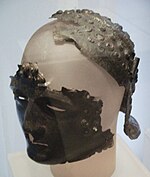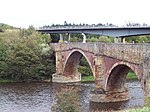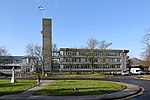Trimontium (Newstead)

Trimontium was a Roman fort complex located at Newstead, near Melrose, in the Scottish Borders, in view of the three Eildon Hills which probably gave its name (Latin: trium montium, three hills). It was occupied intermittently from about 79 to 184 AD and was the largest of the "outpost" forts after the construction of Hadrian's Wall in the 120s AD. It was located 60 miles north of the wall on the extension of Dere Street the main Roman route to the north, initially in seemingly "hostile" territory. Trimontium was about three times larger than any fort on Hadrian's Wall and by 180 became the most northerly settlement of the whole Roman Empire. Trimontium is also considered of international importance as the site of one of the largest caches of Roman military objects in Britain, found in 117 pits.It was identified by Roman geographer Ptolemy in his Geography.The fort sits on the banks of the River Tweed, with the Eildon Hills and the Iron Age hillfort atop Eildon North, a visible reminder of both the local population and imposing landscape of the Scottish Borders. The location benefitted from the rivers Tweed and Leader providing routes for the movement of goods and people and from the Roman road that became Dere Street passing alongside the fort.
Excerpt from the Wikipedia article Trimontium (Newstead) (License: CC BY-SA 3.0, Authors, Images).Trimontium (Newstead)
A6091,
Geographical coordinates (GPS) Address Nearby Places Show on map
Geographical coordinates (GPS)
| Latitude | Longitude |
|---|---|
| N 55.601 ° | E -2.687 ° |
Address
A6091
TD6 9DB
Scotland, United Kingdom
Open on Google Maps









